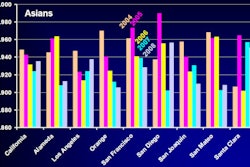Performing ultrasound studies of carotid intima-media thickness (CIMT) provides long-term prognostic value for adverse cardiac events, giving doctors important clues about who is at risk for a heart attack, according to a study published April 6 in the Journal of the American College of Cardiology.
Researchers from Baylor College of Medicine in Houston found that about 23% of patients would be reclassified into a different risk group by adding information obtained from ultrasound assessment of CIMT to traditional risk factors used for predicting future cardiac events. Risk prediction using this approach was more accurate, and it could help better define which patients should be screened with CIMT ultrasound.
"More people were reclassified down rather than up" in risk, said lead author and cardiologist Dr. Vijay Nambi in a JACC video interview accompanying the study's release.
"Noninvasive ultrasound can give us a more complete snapshot of our patients' risk, so we can do a better job determining if they'll have a heart attack," added study co-author Dr. Christie Ballantyne, also from Baylor, in a statement accompanying the release.
Using ultrasound, researchers examined the carotid arteries of 13,145 patients, analyzing the thickness of the artery wall and the presence or absence of plaque inside the artery to determine if these characteristics influenced the traditional risk factors for heart attack and coronary heart disease (JACC, April 6, 2010, Vol. 55:10, pp. 1601-1607).
"We have known that people with heart disease tend to have thicker carotid arteries on ultrasound, but we now know how to use the artery thickness and presence or absence of plaque to better predict who is at risk for heart disease," Nambi said.
The retrospective analysis was performed using data from the Atherosclerosis Risk in Communities (ARIC) study, Nambi said. The risk-prediction models (overall, and separately for men and women) analyzed in the study included traditional risk factors only, traditional risk factors with the addition of CIMT or plaque, and, finally, traditional risk factors plus CIMT and plaque. Traditional risk factors, such as smoking, age, high cholesterol, and comorbidities, were the same as those used in the Framingham study, Nambi explained.
The predictive value of the various combinations for cardiac events was determined by calculating the area under the receiver operator characteristics curve (AUC) adjusted for the phenomenon of "overoptimism" that can occur when the fit of the model is tested using the same data in which it was described.
The researchers used Cox proportional hazards models to estimate 10-year risk of coronary heart disease for each model and determine the number of subjects reclassified. Observed events were compared to expected events.
"Now follow-up has been almost 15 to 17 years, so we used data to evaluate if the addition of [CIMT plus plaque] data was useful to risk stratification," Nambi said. There were 1,822 events over the follow-up period, including 650 coronary revascularization procedures and about 1,200 "hard" events such as myocardial infarction or cardiac heart disease and death, he said.
Of 13,145 eligible subjects (5,682 men, 7,463 women) who were scanned with baseline ultrasound, 23% were reclassified by adding CIMT plus plaque information. Overall, the best improvement of risk (improvement in AUC) was obtained using CIMT plus traditional risk factors plus plaque, the authors reported. Similarly, the CIMT plus traditional risk factors plus plaque improved net classification by 9.9% in the overall population.
The AUC improved from 0.742 (traditional risk factors only) to 0.755 (95% confidence interval for the difference in adjusted AUC: 0.008 to 0.017) in the overall cohort.
As for which component of the ultrasound exam had a greater effect on risk, intima-media thickness "had a lot more additive effect in men and plaque had more additive effect in women," for reasons that are not entirely clear, Nambi said.
One possible explanation is that "since middle-aged women have a relatively low prevalence of atherosclerosis, plaque presence, which reflects a definite area of atherosclerosis, was more powerful than using a sex-specific percentile 'thickness' (CIMT)," the study team wrote. "Similarly, given the overall lower prevalence of atherosclerosis in women, it is possible that a CIMT > 75th percentile misclassifies subjects without atherosclerosis as higher risk, and a specific CIMT cutpoint may be better in women."
The data showed clearly that CIMT plus plaque best improved risk prediction in men and women. And, importantly, the information from CIMT plus plaque reclassified more people to lower risk than to higher risk.
"Almost 61.9% of those reclassified from the intermediate-risk group (5% to 20% estimated 10-year coronary heart disease risk) were reclassified to lower risk," the authors wrote. "Furthermore, nobody from the low-risk group was reclassified to a high-risk group, and nobody from the high-risk group was reclassified to the low-risk group."
"All the action was in intermediate risk," Nambi said in his video interview.
The authors concluded that adding plaque and CIMT to traditional risk factors improved coronary heart disease risk prediction in their study.
"We now have really good evidence that measuring the intimal-medial thickness and plaque of the carotid artery can be significant in the risk stratification of patients with coronary artery disease," Nambi said.
Because changes in risk assessment weighed most heavily on those of intermediate risk for coronary heart disease (i.e., those with a 5% to 20% risk of coronary heart disease over 10 years), CIMT screening should be considered in the intermediate-risk group and not in the population at large.
By Eric Barnes
AuntMinnie.com staff writer
April 8, 2010
Related Reading
Carotid plaque thickness tied to past infections, February 16, 2010
Carotid artery plaque assessment requires more than one imaging modality, December 18, 2009
FDG-PET uptake helps predict vascular events in cancer patients, October 9, 2009
How to navigate pitfalls in carotid ultrasound, September 9, 2009
B-mode US shines in measuring carotid atherosclerosis, September 19, 2008
Copyright © 2010 AuntMinnie.com



















